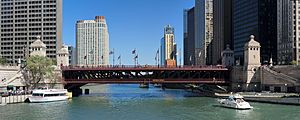Michigan Avenue Bridge facts for kids
Quick facts for kids Michigan Avenue Bridge |
|
|---|---|

The Michigan Avenue Bridge from the west
|
|
| Carries | Cars, trucks, and people |
| Crosses | Chicago River |
| Locale | Chicago |
| Official name | DuSable Bridge |
| Heritage status | Chicago Landmark |
| Characteristics | |
| Design | A special type of bridge that opens in the middle (bascule bridge) |
| Total length | 399 feet (122 m) |
| Width | 91.75 feet (27.97 m) |
| History | |
| Designer | Engineers from Chicago's Public Works Department |
| Construction begin | April 15, 1918 |
| Construction end | 1920 |
| Opened | May 14, 1920 |
The Michigan Avenue Bridge (officially called the DuSable Bridge) is a special type of bridge known as a bascule bridge. It carries Michigan Avenue across the main part of the Chicago River in downtown Chicago, Illinois.
Building the bridge started in 1918. It opened for traffic in 1920. The beautiful decorations on the bridge were finished in 1928.
About the DuSable Bridge
The DuSable Bridge is a very important bridge in Chicago. It helps people and cars cross the Chicago River. This bridge is famous because it can open up in the middle. This allows tall boats to pass through.
The bridge has two levels. The top level carries cars and people. The lower level was once used for traffic too. Today, it is mostly used for utilities and access to nearby buildings.
Why the Bridge Opens
The Michigan Avenue Bridge is a bascule bridge. This means it has two parts that lift up. They are like giant seesaws. This design lets tall boats travel on the Chicago River. The river connects to Lake Michigan.
The bridge opens regularly in spring and fall. This allows boats to move between their winter storage spots and summer docks. It is a cool sight to see!
A Chicago Landmark
The DuSable Bridge is more than just a way to cross the river. It is also a Chicago Landmark. This means it is a very important historical place. It shows off Chicago's amazing engineering and design.
The bridge was named after Jean Baptiste Point DuSable. He was the first permanent non-Native American settler in Chicago. His trading post helped start the city.
Images for kids
-
Michigan Boulevard and bridge, as proposed in the 1909 Plan of Chicago. This view looks north from Grant Park.




